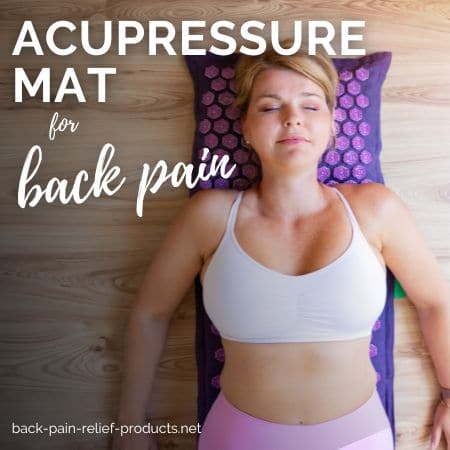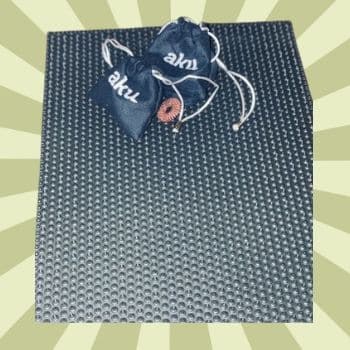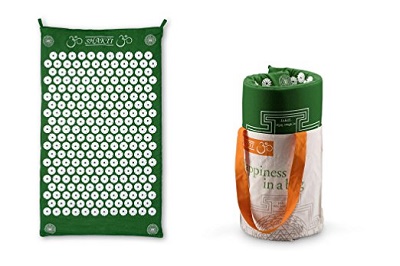An acupressure mat for back pain is an affordable, self-administered acupressure tool, also known as the modern bed of nails.
Recent studies show that people with chronic pain who use acupressure therapy (a traditional Chinese medicine technique) can improve pain and fatigue symptoms.

This post may contain affiliate links, at no extra cost to you.
In this post, you’ll find whether an acupressure mat relieves back pain, how it feels to use it, possible side effects, and the best acupressure mats for back pain relief, according to studies and consumer testimonials.
Overview
What is an Acupressure Mat and How Does it Work?
An acupressure mat looks like a yoga mat that is covered with hundreds of tiny plastic spikes. When you lie on the mat, these spikes become small pressure points that perform acupressure therapy all over the treatment area.
This pressure promotes a quick boost of your blood flow, which brings more oxygen, energy, endorphins, and healing blood components to the back area. The result is pain relief, tension relief, muscle relaxation, and stress relief.
Thousands of people using acupressure mats also report anxiety relief, sleep problems relief, blood circulation problems improvement, headaches and migraines relief, and even better skin complexion.
Acupressure is a 4000+ year-old system of diagnosis and treatment with more than 400 acupoints spread all over the body.
Are Acupressure Mats Proven to Work?
A large systematic review of acupressure and pain relief has a significant positive result and effectiveness of acupressure therapy for a variety of pain symptoms (including lower back pain) and has recommended that health professionals use it for natural pain management.
Research has shown that acupressure therapy, even when it’s self-administered, can relieve symptoms of chronic back pain and fatigue. This small study has shown a 36% reduction of pain, compared to pain relief medication.
An acupressure mat (which is called a “mechanical needle stimulation pad” in studies) is an affordable, non-invasive and simple to use tool to relieve back pain.
However, you shouldn’t expect it to eliminate back pain entirely, and we highly recommend combining it with more drug-free and well-established techniques, such as a home back traction device (back stretcher), an infrared heating pad, and back massagers.
How Does Lying on an Acupressure Mat Feel?
When you lie on an acupressure mat, thousands of tiny spikes are pressed against your skin, so this experience can be intense and quite prickly in the first few minutes. For me, it feels like lowering myself into a bath that’s a bit too hot, which takes a minute to get used to.

To ease into it, we suggest taking a few deep breaths, letting go of everything, and trusting the process. Beginners do not have to use it on bare skin; thin cotton clothing is fine and will not interfere with the treatment.
After a few minutes, this feeling is replaced with a tingly sensation, accompanied by a pleasant warmth. The muscles start to relax, pain evaporates, and tension goes away, with the help of endorphins rushing into your back area.
Most people feel fully relaxed after about 15 minutes, and many people report feeling completely zoned out to the point of falling asleep.
What’s the Best Acupressure Mat for Back Pain?
Through our research, the world’s best acupressure mat in 2025 is the Aku Mat by Akuspike, which is made with 2710 high-grade metal spikes (copper, iron, zinc, nickel, and silver) instead of plastic spikes, over a high-quality rubber mat.
The mat grips well to every surface, to prevent movement while you use it (movement can cause scratching of your skin), and the company offers a lifetime guarantee and a 90-day trial, with free shipping worldwide.
If you are interested in the regular plastic spikes, our top recommendation goes to the original Shakti Mat – see our full Shakti Mat review.

How to Use an Acupressure Mat
See the video below for some of the best positions and ways to use an acupressure mat:
How Long Should You Lie on an Acupressure Mat?
The amount of time it takes for an acupressure mat to relieve back pain can vary depending on the individual and the severity of their pain. Some people may experience relief after the first use, while others may need to use the mat regularly for several weeks to see results.
Beginners can lie on an acupressure mat for 10-15 minutes and gradually increase to 30-40 minutes. It is not recommended to sleep on the mat all night or use it for more than 40 minutes a day.
Acupressure Mat Side Effects
If used incorrectly, an acupressure mat can pierce your skin. Make sure to lie on the mat gradually, starting with your lower back, and slowly lay the rest of your back on the mat.
Some people may experience increased pain or discomfort when using the mat, especially if they have a pre-existing medical condition or if they apply too much pressure. You can reduce the pressure by placing the mat on a recliner, a sofa, or a soft mattress instead of a hard surface like the floor.
Pregnant women and children are advised not to use an acupressure mat. Also, check with your doctor first if you have high blood pressure.
To your health and happiness,
The Back Pain Relief Products Team
Studies
Frizziero A, Finotti P, Scala CL, Morone G, Piran G, Masiero S. Efficacy of an Acupressure Mat in Association with Therapeutic Exercise in the Management of Chronic Low Back Pain: A Prospective Randomized Controlled Study. Applied Sciences. 2021; 11(11):5211.
Chen YW, Wang HH. The effectiveness of acupressure on relieving pain: a systematic review. Pain Manag Nurs. 2014 Jun;15(2):539-50. doi: 10.1016/j.pmn.2012.12.005. Epub 2013 Feb 15. PMID: 23415783.
Susan Lynn Murphy, ScD, OTR, Richard Edmund Harris, PhD, Nahid Roonizi Keshavarzi, MS, Suzanna Maria Zick, ND, MPH, Self-Administered Acupressure for Chronic Low Back Pain: A Randomized Controlled Pilot Trial, Pain Medicine, Volume 20, Issue 12, December 2019, Pages 2588–2597
Hohmann, C., Ullrich, I., Lauche, R., Choi, K. E., Lüdtke, R., Rolke, R., Cramer, H., Saha, F. J., Rampp, T., Michalsen, A., Langhorst, J., Dobos, G., & Musial, F. (2012). The benefit of a mechanical needle stimulation pad in patients with chronic neck and lower back pain: two randomized controlled pilot studies. Evidence-based complementary and alternative medicine : eCAM, 2012, 753583.

